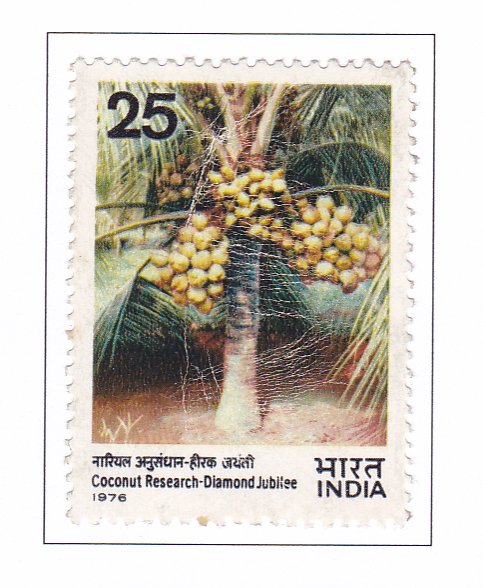Diamond Jubilee of Coconut Research

Technical Data
| Date of Issue | December 27, 1976 |
|---|---|
| Denomination | 25 p |
| Quantity | 3,000,000 |
| Perforation | comb 13 |
| Printer | Security Printing Press, Nashik |
| Watermark | No Watermark |
| Colors | Multicolor |
| Catalog Codes |
Michel IN 702 Stamp Number IN 745 Yvert et Tellier IN 504 Stanley Gibbons IN 835 |
| Themes | Agriculture | Anniversaries and Jubilees | Fruits and Berries | Palm-trees | Plants (Flora) | Trees |
The coconut tree, aptly termed Kalpavriksha or the all-giving tree in Indian literary classics, holds a significant place among the legendary Devvikshas or Godly trees. This majestic tree not only stands as a symbol of abundance but also serves as a vital resource for mankind, providing a multitude of essential needs.
With its strong and elongated trunk, reaching up to 30 meters, and crowned by graceful, featherlike leaves, the coconut tree is renowned for its beauty and resilience. Every part of the tree serves a variety of purposes, making it one of the most important tree crops globally.
The dried kernel of the coconut yields oil, which serves as a wholesome cooking medium and finds applications in soap manufacturing, detergents, synthetic rubber, and glycerine production. Coconut water, extracted from the fruit, is a delicious and nutritious beverage, while the tender kernel is a delicacy enjoyed in various culinary preparations.
The husk of the coconut provides versatile fiber, used for making ropes, mats, baskets, brushes, brooms, and rubberized mattresses. The young inflorescence yields a refreshing beverage when tapped, which can also be fermented to produce a mild alcoholic drink. Additionally, sugar can be extracted from the fresh sap.
Even the coconut shell finds diverse uses, serving as fuel, drinking bowls, ladles, bangles, buttons, and more. The trunk of the palm is utilized as building material, commonly known as ‘porcupine wood,’ while the mature leaves are woven into thatching and basketry.
Geographically, coconut holds the top position among oil-yielding crops, cultivated in 76 developing countries worldwide. Interestingly, the Indian state of Kerala, with its literal translation as the land of coconuts, reflects the significance of this tree in its culture and economy. A large percentage of Kerala’s population depends on coconut for their livelihood.
India’s systematic research on coconut began in 1916, with research stations established in Kasaragod and Nileshwar. These stations, now part of the Kerala Agricultural University and the Central Plantation Crops Research Institute, respectively, have contributed significantly to coconut research globally.
The Diamond Jubilee of coconut research in India is being celebrated this year, commemorating six decades of advancements in coconut cultivation, product development, pest control, and disease management. As part of these celebrations, an International Symposium on coconut is being organized at Kasaragod. In honor of this milestone, the Posts and Telegraphs Department is pleased to issue a postage stamp, acknowledging the contributions of coconut research to India’s agricultural landscape.
